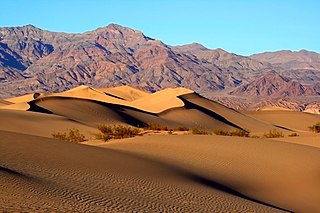
The Mojave Desert is a desert in the rain shadow of the southern Sierra Nevada mountains and Transverse Ranges in the Southwestern United States. It is named for the indigenous Mojave people. It is located primarily in southeastern California and southwestern Nevada, with small portions extending into Arizona and Utah.

Lycaenidae is the second-largest family of butterflies, with over 6,000 species worldwide, whose members are also called gossamer-winged butterflies. They constitute about 30% of the known butterfly species.

Eriogonum fasciculatum is a species of wild buckwheat known by the common names California buckwheat and flat-topped buckwheat. Characterized by small, white and pink flower clusters that give off a cottony effect, this species grows variably from a patchy mat to a wide shrub, with the flowers turning a rusty color after blooming. This plant is of great benefit across its various habitats, providing an important food resource for a diversity of insect and mammal species. It also provides numerous ecosystem services for humans, including erosion control, post-fire mitigation, increases in crop yields when planted in hedgerows, and high habitat restoration value.

Euphilotes is a genus of butterflies in the family Lycaenidae, which consists of a number of species found in western North America. Some of the species are endangered, such as the Smith's blue, Euphilotes enoptes smithi.

Euphilotes rita, the rita blue or desert buckwheat blue, is a species of butterfly of the family Lycaenidae. It is found in Wyoming, Colorado, Arizona, New Mexico and northern Mexico. The species was first described by William Barnes and James Halliday McDunnough in 1916.

Euphilotes battoides, the square-spotted blue or buckwheat blue, is a species of butterfly of the family Lycaenidae. It is found in western North America from California south to Baja California Norte and then west to southern Colorado and New Mexico. This species may also occur in Oregon and Washington, but more study is needed to verify this.

Euphilotes pallescens, the pale blue, pallid blue or pallid dotted blue, is a species of butterfly of the family Lycaenidae. It is found in the United States in southeastern California, Nevada, southern Utah and northern Arizona.
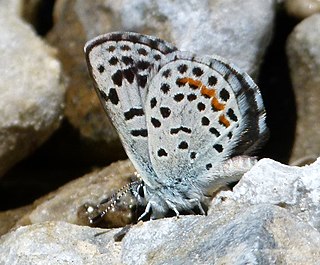
Euphilotes ancilla, the Rocky Mountain dotted blue, is a species of butterfly of the family Lycaenidae. It is found from Washington south to California and southern Alberta and Saskatchewan south through the Rockies and high plains to Wyoming, Colorado, Utah, and northwestern New Mexico. The species was first described by William Barnes and James Halliday McDunnough in 1918.
Arethaea coyotero, known generally as the Mojave thread-leg katydid or coyotero thread-leg katydid, is a species of phaneropterine katydid in the family Tettigoniidae. It is found in North America.
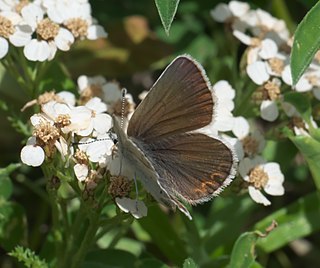
Plebejus anna, or Anna's blue, is a species of blue in the butterfly family Lycaenidae. It is found in North America.

Celastrina echo, known generally as the echo azure or western azure, is a species of blue in the butterfly family Lycaenidae.

Euphilotes bernardino, the Bernardino blue, is a butterfly in the family Lycaenidae. The species was first described by William Barnes and James Halliday McDunnough in 1916. It is found in North America.

Satyrium semiluna, known generally as the sagebrush sooty hairstreak or half-moon hairstreak, is a species of hairstreak in the butterfly family Lycaenidae. It is found in North America. The MONA or Hodges number for Satyrium semiluna is 4277.1.
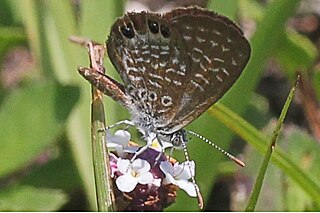
Brephidium pseudofea, the eastern pygmy-blue, is a species of blue in the butterfly family Lycaenidae. It is found in the southern United States, typically in coastal saltmarshes.
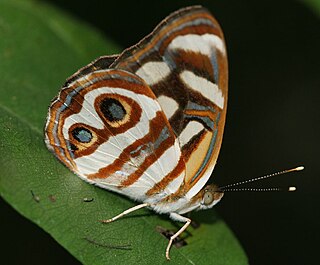
Dynamine dyonis, the blue-eyed sailor, is a species of tropical brushfoot in the butterfly family Nymphalidae. It is found in North America.

Memphis pithyusa, known generally as the pale-spotted leafwing or blue leafwing, is a species of leafwing in the butterfly family Nymphalidae. It is found in southern North America.
Philotiella speciosa, the small blue, is a species of blue in the butterfly family Lycaenidae.
Euphilotes spaldingi, or Spalding's blue, is a butterfly of the family Lycaenidae. The species was first described by William Barnes and James Halliday McDunnough in 1917. It is found in North America.

Cyclargus ammon, known generally as the nickerbean blue or Lucas' blue, is a species of blue in the butterfly family Lycaenidae. It is found in the Caribbean Sea and North America.















